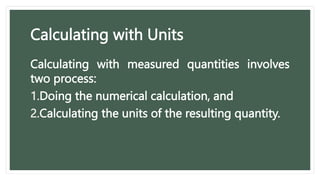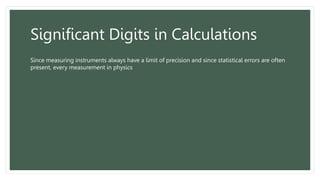Physics Week 1.pptxxxxxxxxxxxxxxxxxxxxxxxx
- 2. WEEK 1LESSON 1 ’ā╝ What is Physics ’ā╝Counting and Measuring Accuracy and Precision ’ā╝Dimensions and Units of Measure ’ā╝Calculating and Converting ’ā╝Significant Digits
- 3. Physics is a body of knowledge that provide organized answer to our questions about the physical world. Its goal: to describe all phenomena in the physical world in terms of a few fundamental relationships (called the laws of Physics) between measurable properties of matter and energy. All phenomena in the physical world Physical Laws Mathematical Form Quantitative Results
- 4. Counting and Measuring: Accuracy & Precision Precision One of the simplest methods of quantifying is to count. This methods is applicable wherever we have individual units, such as apples, oranges, people, or atoms. In principle, counting is an exact process of quantifying because we are using whole numbers, or integers, to express a quantity.
- 5. Another method of quantifying is to measure. Unlike counting, the process of measurement is not exact. When we measure, we are no longer using integers to determine quantity. Instead we are using the markings on a meter stick, or thermometer, or the ticks of a clock to measure quantities of length, temperature and time. All such marks and ticks have an inherent limit of precision that is determined by the design and construction of the measuring device. A general guideline is that a given measuring device has a limit of precision equal to one half the smallest division of measurement built into the device.
- 7. The limit of precision of a measuring device is ┬▒ ┬Į the smallest division of measurement the device is able to display. Thus: A meter stick with 1 mm division has a limiting precision of ┬▒ 0.5 mm. A vernier caliper that can be read to the nearest 0.1 mm has a limiting precision of ┬▒ 0.05 mm. A stopwatch with 0.5 second intervals has a precision of ┬▒ 0.25 s. A digital stopwatch that displays to the nearest 0.1 s has a limiting precision of ┬▒ 0.05 s.
- 8. Accuracy A different kind of measurement uncertainty involves the possibility of of incorrect design or calibration of the instrument, or incorrect reading or interpretation of the instrument. Such errors are called systematic errors. These errors cause the measurement to be consistently higher or lower than the true value. Such a measurement is said to be inaccurate.
- 9. Random errors or statistical errors -Is multiple measurements of the same quantity using the same instrument often differ by more than the precision of the instrument. -Caused by fluctuations on the physical property being measured. i.e: changes in temp, gas pressure, elec. Voltage etc. -It cannot be eliminated -But can be reduced by increasing the number of measurements.
- 10. Accuracy is the extent to which systematic errors make a measured value differ from its true value.
- 12. Dimensions and Units in Measurement When measuring a physical quantity, we first have to identify what kind of physical property we are measuring. There are only seven basic kinds of physical properties necessary to describe all physical measurements. These properties are called dimensions. They are: Length mass time temperature electric current Number of particles luminous intensity
- 13. With each dimension, there is an associated unit. The fundamental dimensions and their basic SI units are shown. Dimension Unit Symbol Length meter m Mass kilogram kg Time second s Temperature Kelvin K Electric current Ampere A Number of Particles Mole M Luminous Intensity Candela cd
- 14. Calculating with Units Calculating with measured quantities involves two process: 1.Doing the numerical calculation, and 2.Calculating the units of the resulting quantity.
- 15. Examples: Dividing 60 miles (mi) by 2 hours (h) gives: 60 mi = 30 mi = 30 mi/h 2 h h Multiplying 3 kilograms (kg) by 12 meters per second (m/s): 3 kg x 12 m/s = 36 kg . m/s
- 16. Converting Between Systems of Units The units used in various systems to measure a dimension usually have different names and represent different amounts of the dimension. We can convert any measurement from one system to another by using the appropriate equivalencies, called conversion factors. For example: 1 ft = 0.3054 m We read this as: ŌĆ£There are 0.3054 meters in one foot (0.3054 m/ 1 ft)ŌĆØ or ŌĆ£There is one foot in 0.3054 meters (1 ft/0.3054 m)ŌĆØ
- 17. Examples: a) Convert 20.0 ft into meters. b) Convert 60.0 mi/h to m/s. Ans. a. 6.10 m b. 26.8 m/s
- 18. a)Convert 20.0 ft into meters. 1 ft = 0.3054 m Therefore, 20 ft = 20 x 0.3054 = 6.108 m b. Convert 60.0 mi/h to m/s. 1 mi/h 1610m/3600s Therefore, 60 mi/h = (60 x 1610)/3600 m/s = 26.83 m/s
- 19. Converter: 1 inch = 2.54 cm 1 ounce = 0.03 liter 1 ton = 1.016 kg
- 20. Significant Digits in Calculations Since measuring instruments always have a limit of precision and since statistical errors are often present, every measurement in physics



















